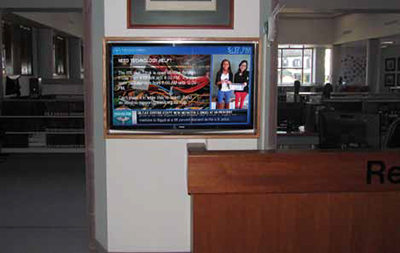The Hill School Extends Communications with Digital Signage
The digital signage system at The Hill School is a campus-wide deployment with displays mounted in the administrative offices, admissions office, head master’s office, dining hall, student center, student grill, library lobby, center for the arts, and athletic department. POTTSTOWN, PA—The Hill School is a preparatory boarding school for boys and girls located in Pottstown, PA. Established in 1851, The Hill values its history and traditions, but recognizes that to thrive today, it must also have an energetic level of innovation on campus and in the classroom.
Before the 2013-2014 school year, The Hill School embarked on a massive technology upgrade that included presentation systems for all the classrooms, iPads for students, and the installation of a campus-wide digital signage system based on CastNET Content Management System (CMS) software.
“We have over 500 students and over 180 faculty and staff who mostly live on campus. Communicating with this residential community has always been a challenge,” said Kyle Jones, director of information and technology services. “We send out lots of emails, but everyone seems to be overloaded with emails. We make announcements at our daily seated lunch with students and faculty, but the time there is limited. We wanted a digital signage system that would give us another method to effectively communicate with people on campus.”
Jones had been involved in managing digital signage systems in the past, but found them to be ineffective because the content was difficult to create and schedule. “After a few months, we were ready to take them down because nobody was updating the content,” added Jones. “For the digital signage at the Hill School, it was crucial that we found a system that was ridiculously simple for the average user to use so we could leverage what I call ‘distributed authoring’. We wanted multiple people and departments creating and posting content.”
The digital signage system at The Hill School is a campus-wide deployment. One Sharp and several Toshiba displays were integrated via Kramer Electronics cables and hung with Chief LTMU mounts in the administrative offices, admissions office, headmaster’s office, dining hall, student center, student grill, library lobby, center for the arts, and athletic department. “As the system was installed, we distributed the authority to create content. Using the template-based CastNET software, our departments quickly found it easy to provide updated content. We now have about 15 organizations and departments adding content to the system.”
The solution provided by IMS is a CastNET Cloud system, which means that the digital signage server is located and maintained at CastNET’s secure off-site data center. CastNET Cloud is a cost-effective solution, since a long-term investment in server hardware is not required. The system has two channels; one channel is used by the library and all the other departments use the campus-wide channel. The screen layout for the campus-wide channel has a main content frame that shows scheduled messages, a bottom frame running the CastNET NewsJET scroll, and a right frame for announcements and weather.
Mike Shinn, operations director at IMS Technology, discussed the installation, “Along with its honored academic traditions, The Hill School is known for its historic architecturally-unique facilities. Historic buildings usually mean challenging system integration and that was certainly the case when it came time to install the digital signage system.”
Shinn explained, “For example, in the athletic building, we were asked to mount the digital sign on a cinder-block wall covered with elaborate glazed tile. We hired a specialty sub-contractor to carefully drill through the glazed tile and then worked with the on-staff electrician to thread the power and data cords through a one-inch crooked path between the cinder blocks. Throughout the rest of the campus, most of the interior walls are covered with ornate, handcrafted wood paneling. The challenge in those locations was to install the digital signs so the new technology doesn’t stick out like a sore thumb against the wood paneling. The solution in several locations was to have a cabinet maker create a wood frame to house the monitors that matched the wood paneling.”
Shinn added, “IMS Technologies was successful in this installation because we made sure to operate as a team with the in-house electricians, in-house carpenters, and the data subcontractors who knew the facilities better than us.










